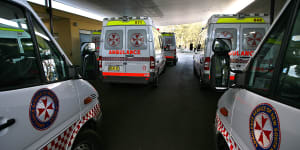Paramedics warn that response times that are blowing out are putting lives at risk as NSW hospitals deal with a deluge of patients and not enough beds to cater for them.

Stuck in the driveway:Huge demand has meant ambulances are forced to wait outside hospitals which can’t cope with the demand.Robert Pearce
for January to March reveals about 62 per cent of patients who need a lights-and-sirens emergency response did not get an ambulance within the 15-minute benchmark,a 25 percentage point drop from the same time five years ago.
“On all fronts,the health system is under serious strain and on many measures we are no longer meeting clinical standards we set for ourselves,” NSW Australian Medical Association president Dr Michael Bonning said.
“Many patients have delayed or deferred care during the pandemic,and we are seeing higher-acuity patients arriving to emergency with more complex needs.”
Triple-zero calls soared to more than 375,000 – the highest number on record in more than a decade and about 50,000 more calls than at the same time last year. There were just over 9300 responses for the most severe life-threatening emergencies,such as anaphylaxis or where a patient is unconscious,a record for any quarter since reporting began.

About 40 per cent of the most severe life-threatening cases did not receive a response within the 10-minute benchmark.
Secretary of the Health Services Union,Gerard Hayes,said record triple-zero calls and health staff off work with COVID-19 during the height of Omicron,meant paramedics were not able to get to jobs on time.
“A moment delayed is a moment lost,so when you are being delayed getting to someone who has a significant issue or injury,that’s when the clock starts and it does impact care,” he said.
State president of the Australian Paramedics Association Chris Kastelan said the figures were part of the “sad but ongoing story” of paramedics struggling to respond in a timely manner due to poor resourcing.
He said delays in responding to P1 cases,which include chest pain,strokes and shortness of breath,meant there was a “much higher chance of an adverse outcome”.
The result of mere minutes’ delayed attendance at P1A cases,such as a stopped heart,a patient unable to breathe,or anaphylaxis,could also be life-threatening,he said.
“We are seeing very unwell people who have waited a long period of time for care.”
The Bureau of Health Information Quarterly report,released on Wednesday,also shows elective surgery waitlists have blown out to 100,980 patients,just short of the.
The number of people who waited longer than clinically recommended by the end of March was 18,627,the highest for any quarter in more than 10 years.
NSW Health secretary Susan Pearce said surging Omicron infections and thousands of healthcare workers off sick or isolating this year had a significant impact on hospitals.
“We’ve never had a quarter where we had 1.4 million COVID cases,” Pearce said.
“At one point we had 6200 health staff furloughed. There has been an incredible effort made by the tens of thousands of health staff in our system working all day every day in PPE,but that slows things down,as does managing people in COVID pathways and isolating patients.”

The number of people waiting for knee replacements rose to more than 7800 (up 15 per cent in a year),including 1522 who had waited longer than clinically recommended. The waitlist for hip replacements passed 3500 (up 14 per cent),including 625 overdue.
For non-urgent surgery,one in 10 patients waited longer than 465 days – longer than at any time since 2010.
Andrew Zuschmann,chair of AMA NSW Hospital Practice Committee,said the “whole system is at capacity”.
“Ambulances are ramped and unable to offload patients because the emergency departments are full. Emergency is full because all the wards are full.”
He said better co-ordination was needed with private hospitals to bring skyrocketing waiting lists down.
Bonning said patients that should have been seen with stable clinical problems have delayed care and “by the time they get seen can often have deteriorated”.
“These results show there isn’t sufficient staffing and funding in the system. There should be better co-ordination of care. If the system is under such big strain with no capacity then the opportunity to bring patients in planned admissions for complex medical problems is lost.”
The number of people attending emergency departments over the quarter peaked in January,as NSW recorded tens of thousands of COVID-19 cases each day.

But with hospitals short on staff and emergency rooms stretched,a record 55,305 people left without completing treatment. About 161,000 people received admission to emergency during the quarter,down 15.6 per cent compared to 2019.
Across the state,an average of 70.5 per cent of patients in emergency started treatment on time,but among principal referral hospitals this figure ranged from fewer than 50 per cent at Westmead and Gosford to 75 per cent at Concord.
One in 10 waited almost an hour in ambulances outside hospital to be transferred to emergency,up from 32 minutes in 2019.
Stay across the most crucial developments related to the pandemic with the Coronavirus Update..